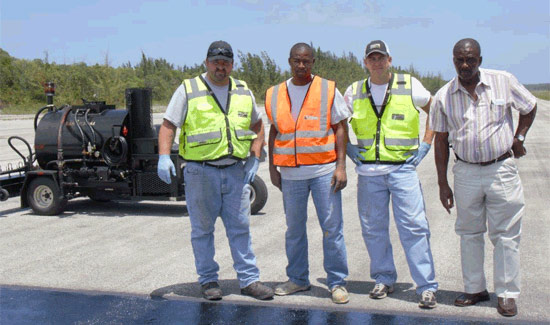Road Traffic Act Amendment Bill
Moved by Neko Grant
Minister of Public Works and Transport
October 26, 2011
Mr. Speaker:
Members would be aware that the New Providence Transport Programme seeks to improve the existing road network, modernise and strengthen the institutional framework for provision of transportation services, improve road safety and alleviate negative environmental impact associated with existing levels of traffic congestion.
The institutional strengthening component of the New Providence Transport Programme is comprised of six (6) areas, one of which is the review of the Road Traffic Act.
Bearing this in mind, the Road Traffic (Amendment) Bill 2011 is another step in that direction. The proposed amendments to the Road Traffic Act (Chapter 220) as advanced in this Bill address among other issues, several major road safety concerns as they relate to the existing act. The proposed amendments include provisions for the elimination of Road Act insurance, the more effective enforcement of seatbelt legislation; application of the choice of specimen in determining whether or not a driver’s ability to drive is impaired, and the removal of the requirement for the presence of a police officer at the scene of every vehicle collision.
Clause 2 makes provision for compulsory third party insurance coverage thereby eliminating the use of “Road Act” insurance coverage. However, it should be noted that a ‘valid and subsisting’ Road Act Insurance policy certificate issued before commencement of the Act shall remain in force until its expiration. This amendment provides enhanced protection of drivers and passengers as the new minimum compulsory insurance covers third party damage as well as bodily injury and/or death of all passengers.
Clauses 3, 4 and 5 facilitate the more effective enforcement of seatbelt laws. In this regard these amend sections 42B, C and D of the principal act. Taxicabs and trucks are exempted from mandatory fitting of seat belts except the driver’s front seat and any seat alongside the driver. Other specified vehicles exempted include custom designed vehicles for disabled persons displaying disabled signs under certain conditions, motor vehicles manufactured before 1972, and golf carts in locations where they are permitted on a public roads. There are some concerns about this, but there are a number of communities that are predominantly golf cart communities. There are also several communities where the mode of transportation should be restricted to golf carts so the fitting of seat belts on golf carts is something we may want to revisit at a later date. We must start somewhere and this Bill does that.
Temporary exemptions may also be granted by a certified medical practitioner for the driver or passenger of a vehicle for specified periods due to some medical impairment.
Obligations are imposed on drivers to ensure passengers and specified categories of children are restrained. In the case of children who are not properly restrained, the proposed fine is $100 on summary conviction. There are some who feel that this fine is inadequate. We will revisit, as a strong message must be sent that our children must be protected.
Any driver of a motor vehicle driving without a seatbelt or allows a passenger to ride without a seatbelt is liable to a fine on summary conviction not exceeding one hundred dollars, community service order, suspension of driver’s license for one year or a combination of the fine and community service.
Fines have also been amended for sale or hiring of vehicles without seat belts. In this regard they have been revised from $500 for first offence to $300 for first offence and from $1,000 for second offence to $500 for second offence.
The Bill also seeks to strengthen passenger safety in trucks. Clause 6 provides for a new section 42E that forbids passengers sitting or standing on the fenders or tailgates of trucks. It is noted that this is the way that many of our small contractors transport their workers. However, all passengers not seated in the cab, are required to sit on the bed of the vehicle. Any driver who allows passengers to sit or stand on fenders or tailgates of trucks is liable on summary conviction to a fine not exceeding two hundred dollars for a first offence and not exceeding five hundred dollars for a second or subsequent offence. If a passenger (who is not a minor) commits this offence, he or she is liable to a fine of one hundred dollars.
Mr. Speaker:
Driving under the influence of drink or drugs is addressed in Clauses 7 through 9. To this end, section 49 of the principal act is being repealed and replaced. Clause 7 outlines the fines and terms of imprisonment on summary conviction of driving or being in charge of a motor vehicle when under the influence of drink or drugs. Clause 8 amends Section 49B (7) by the insertion of the words “blood or” after the words “specimen of” so that it reads “a person who, without reasonable excuse, fails to provide a specimen of blood or urine when required to do so in pursuance of this section is guilty of an offence.”
The fines in this regard are outlined at Section 49 subsections (2) and (3).
With regard to the requirement of production of two specimens of breath under Section 49, provision is now made in the proposed Section 49C for the choice of specimens whereby the specimen with the lower proportion of alcohol content in the breath will be used. This section further states “if the specimen with the lower alcohol contains no more than 50 micrograms of alcohol in 100 millilitres of breath, the person who provided it may claim that it should be replaced by such specimen as may be required by Section 49B (4) and if he provides such specimen, neither specimen of breath shall be used.” The Minister may also substitute (by regulations) another proportion other than that of 50 micrograms of alcohol in 100 millilitres of breath. Sections 49D and E replace Sections 49C and D of the principal act as they relate to protection for hospital patients and detention of persons affected by alcohol or drugs.
Section 49F outlines use of specimens in proceedings for an offence. Section 49G outlines the procedure for production of documentary evidence as to specimens in proceedings.
Section 49H replaces Section 49E of the principal act for the interpretation of Sections 49A through G of this act. Most significant are the definition of “alcohol” meaning “ethanol (ethyl alcohol)” and the definition of “prescribed limit.” For the purposes of this act (as the case may require) this means:
• 35 micrograms of alcohol in 100 millilitres of breath;
• 80 milligrammes of alcohol in 100 millilitres of blood (0.08%). This corrects a typographical error in the principal act which states 80 milligrammes of alcohol in 10 millilitres of blood, and
• 107 milligrammes of alcohol in 100 millilitres of urine (0.11%).
Mr. Speaker:
Provision is also made in the Bill to remove the requirement for a police officer to be summoned to the scene of every accident. This has been advanced in an effort to reduce traffic congestion on our streets when as a result of the collision there is no death, no serious personal injury and no serious damage to vehicles.
We recognise that this (sub-section 1) is discretionary and could be abused through the provision of false names and addresses or through the use of intimidation tactics by persons with outstanding police warrants or other reasons to evade the police. There is also potential for abuse by persons seeking to escape liability when they are at fault for possible injury to the other driver or damage to the driver’s vehicle that might not be detected or might not be overtly apparent at that specific time.
According to the proposed amendment, police presence is not ‘required.’ However, it does not state that it is not to be requested if deemed necessary. The proposed amendment states that a report may be made to a police station or a police officer. Therefore, the option to call for police assistance has not been denied.
Mr. Speaker:
Additionally, the issue of liability that may result from removal of an injured accident victim from the scene of a collision by a private individual in a private vehicle has been raised at sub-section 5. This sub-section allows a party to the accident to leave the scene to transport a seriously injured person to hospital “where no suitable means of conveyance other than a vehicle involved in the accident is at hand.”
This would in most cases apply to collisions in family islands where the capacity to provide ambulance services or first response personnel in every settlement on every island remains somewhat limited. New Providence on the other hand is equipped with significantly more emergency response resources that include a 919/911 emergency dispatch system that is designed to alert all emergency services (police, fire and ambulance) to respond as requested. The application of this provision on New Providence should therefore be very rare and only in highly exceptional circumstances.
Mr. Speaker:
Reference is also made in the Bill to fixed penalty offences. In this regard, I encourage motorists to educate themselves with regard to these offences and the relevant penalties. (Insert examples of fixed penalties here) I also entreat members of the public to always obey the rules of the road.
This legislation insofar as it relates to road safety is timely. On 20 November we will observe the World Day of Remembrance for Road Traffic Victims. Perhaps some persons listening today are not aware of this observance. However it was first introduced in 1993 by Road Peace – a UK based charity and advocacy group for road safety and road danger reduction. Six (6) years ago this month (in October, 2005,) the United Nations General Assembly adopted a resolution that urged all member states to observe the third Sunday in November (each year) as World Day of Remembrance for road traffic victims. In addition to paying tribute to road traffic victims, the United Nations resolution called for attention to be given to five (5) specific safety measures that include action to discourage consumption of alcohol by drivers.
The Road Traffic Department will continue to work along with other sectors in advancing targeted public education programs and campaigns to promote road safety. Over the years, particular emphasis has been placed on increasing public awareness of the Highway Code which is accessible on-line. The Student Driver Education Programme and the Safe Driving Simulator Programme for high school students have been introduced.
The Department has also sustained initiatives to remind the public of risks to the safer use of our streets which cannot be overemphasised in this country. These include failure to use seat belts and car seats, excessive speed, and impairment as a result of alcohol consumption which all feature prominently in the proposed amendments to the Road Traffic Act.
While distracted driving (as it relates to cellular phone use) is not specified in this legislation (Section 46 of the principal act refers generally to “careless driving”,) the Road Traffic Department also highlights this particular risk to safe driving in its education programmes.
Mr. Speaker:
In advancing these road safety initiatives we are grateful to Government agencies, Non-Governmental organisations and the private sector, which have collaborated with us in raising awareness of road safety. This multi-sectoral collaboration is crucial as:
• It allows our message of road safety to reach many more individuals,
• It allows us to gain greater insight into the context in which motor vehicle collisions occur; thereby allowing us to target our efforts (from public education to road network design) with greater precision, and
• It contributes to the overall effectiveness and sustainability of the various programmes that are implemented.
The Road Traffic (Amendment) Bill that we debate today complements these efforts. Mr. Speaker, I so move.



